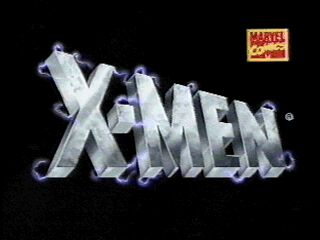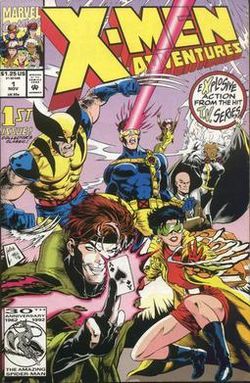X-Men (TV series) facts for kids
Quick facts for kids X-Men |
|
|---|---|
 |
|
| Genre | Superhero Action Adventure |
| Developed by | Eric Lewald Sidney Iwanter Mark Edens |
| Voices of |
|
| Theme music composer | Ron Wasserman |
| Composer(s) |
|
| Country of origin | Canada United States |
| Original language(s) | English |
| No. of seasons | 5 |
| No. of episodes | 76 (list of episodes) |
| Production | |
| Executive producer(s) | |
| Producer(s) | Will Meugniot Larry F. Houston |
| Running time | 22 minutes |
| Production company(s) |
|
| Distributor | 20th Television Saban International |
| Release | |
| Original network | Fox Kids Network |
| Original release | October 31, 1992 – September 20, 1997 |
| Chronology | |
| Preceded by | X-Men: Pryde of the X-Men |
| Followed by | X-Men: Evolution |
X-Men (also known as X-Men: The Animated Series) is a popular superhero cartoon show. It first aired on October 31, 1992, in the United States on the Fox Kids Network. This show was Marvel Comics' second try at an animated X-Men TV series. Their first attempt, X-Men: Pryde of the X-Men, was a pilot that didn't get picked up for a full series.
Contents
How the Show Was Made
In 1991, Margaret Loesch became the head of Fox Children's Network. She really liked the idea of an X-Men show. So, she quickly ordered 13 episodes of X-Men. A company called Saban Entertainment was hired to make the show. They then brought in a smaller studio, Graz Entertainment, to help. Graz Entertainment handled the creative side, like writing the stories and designing the characters.
The voice actors recorded their lines in Canada. A South Korean studio called AKOM was hired to do the animation. The show was supposed to start in September, but there were some delays. When AKOM sent the first episode, it had many animation mistakes. They refused to fix them. Because there wasn't much time, the episode aired with these errors. Fox was very unhappy and threatened to cancel AKOM's contracts. Later, when the pilot was shown again in 1993, the mistakes were fixed.
The series was very popular from the start. It got high ratings and was renewed for a second season. Throughout the show's run, the creators had to deal with keeping the quality high. They also had requests to make the show more kid-friendly. Sometimes, they were asked to include toys that were being sold. The show was originally planned for 65 episodes. But because it was so successful, more episodes were made. Other animation studios also helped with the show.
What the Show Was About
The X-Men show featured a team of mutants. They looked similar to the characters from the early 1990s X-Men comic books. The main team included Cyclops, Wolverine, Rogue, Storm, Beast, Gambit, Jubilee, Jean Grey, and Professor X. There was also a new character named Morph.
The series often explored important real-world topics. These included family issues, different beliefs, and feelings of being alone. It also touched on serious historical events. The show even made fun of television itself in some episodes.
The X-Men also met Spider-Man in a special crossover. Spider-Man needed their help with a problem he was having. In another big story, the Beyonder and Madame Web chose Spider-Man to lead a team of heroes. Storm was part of this team, fighting against a group of villains.
Main Storylines by Season
Season 1: New Threats and Challenges
The first season showed the X-Men fighting against human groups. These groups were building giant robots called Sentinels to hunt mutants. They also faced Magneto, who wanted to start a war between humans and mutants. Another big villain was Apocalypse. He planned to get rid of anyone he saw as weak. During this season, one of the X-Men, Morph, seemed to die. Beast was also put in jail. There was even an attempt to hurt a US senator. This was done to make humans hate mutants even more.
Season 2: Weddings, Brainwashing, and Plagues
In the second season, Cyclops and Jean Grey got married. But they became targets of Mister Sinister. He wanted to use their perfect DNA to create an army of mutants. Morph returned, but he had been brainwashed by Sinister. He tried to break the X-Men apart. This season also showed the growing conflict between humans and mutants. An anti-mutant group called the Friends of Humanity led the persecution. Apocalypse came back too. He created a dangerous illness and blamed it on mutants. Meanwhile, Professor X and Magneto were lost in a wild place called the Savage Land.
Season 3: The Phoenix Force
The third season focused on a powerful space energy called the Phoenix. This energy merged with Jean Grey. It eventually turned her into the evil and super-powerful Dark Phoenix. This season also introduced the Shi'ar Empire. They were an alien race who wanted to stop the Dark Phoenix. Other stories included Wolverine's old friend, Lady Deathstrike, and the return of former X-Men member Iceman. The villainous Shadow King also appeared.
Later Seasons: More Adventures
The show continued with more exciting stories. Many of these stories were inspired by the original X-Men comic books. For example, some episodes were based on famous comic storylines like "Days of Future Past" and "The Dark Phoenix Saga." These stories were changed a bit to fit the cartoon show. The show also created some original stories that later inspired new comic books.
Meet the Voice Cast
The voice acting for the series was recorded in Toronto, Canada. Dan Hennessey was the voice director. Many of the voice actors had worked on Marvel cartoons before.
Main Voice Actors
- Cyclops / Scott Summers (Norm Spencer): He is the second-in-command of the X-Men. Cyclops can shoot powerful blasts from his eyes. He and Jean Grey have a long-term relationship and get married.
- Wolverine / Logan (Cathal J. Dodd): Wolverine has amazing healing powers. He also has super senses and a strong skeleton with sharp claws. He was interested in Jean Grey, but he respected her relationship with Cyclops.
- Rogue (Lenore Zann): Rogue can absorb memories, powers, and energy from people she touches. If she holds on too long, their mind can get stuck in hers. She permanently gained super strength, toughness, and flight from Ms. Marvel.
- Storm / Ororo Munroe (Iona Morris (1992–1993), Alison Sealy-Smith (1993–1997)): Storm can control the weather. She uses her powers to fight or fly. She must control her feelings, because they are linked to her powers. If she loses control, she could create dangerous weather.
- Beast / Dr. Henry "Hank" McCoy (George Buza): His mutation gives him blue fur and changes his body. He has super strength and agility, and he is also a genius. He spent much of the first season in prison.
- Gambit / Remy LeBeau (Chris Potter (1992–1996), Tony Daniels (1997)): Gambit can charge objects with explosive energy. He often uses playing cards as bombs. He also uses a staff for fighting up close.
- Jubilee / Jubilation Lee (Alyson Court): Jubilee is the newest and youngest member of the X-Men. She is close to Wolverine. Her powers let her create firework-like explosions.
- Jean Grey / Phoenix (Catherine Disher): Jean is a powerful telekinetic (she can move things with her mind) and telepath (she can read minds). She is in a long relationship with Cyclops.
- Professor X / Charles Xavier (Cedric Smith): He is the founder and leader of the X-Men. Professor X is a very strong telepath. He fights for mutant rights and teaches his students important lessons.
Other Cool Stuff
The X-Men animated series had a very famous opening theme song. This song was used for the first four seasons. A slightly changed version appeared in season five. In Japan, the show had different opening and closing songs. The Japanese version also had special segments. These segments promoted the X-Men: Children of the Atom video game.
The show is now available to watch on the Disney+ streaming service. It launched on November 12, 2019.
Comic Books and Video Games
X-Men Adventures Comics
| X-Men Adventures | |
|---|---|

X-Men Adventures vol. 1 #1 (Nov 1992).
Art by Steve Lightle. |
|
| Publication information | |
| Publisher | Marvel Comics |
| Schedule | Monthly |
| Format | Ongoing |
| Publication date | November 1992–March 1997 |
| Number of issues | 53 |
| Main character(s) | X-Men |
A comic book series called X-Men Adventures was created based on the cartoon. It started in November 1992. These comics retold stories from the first three seasons of the show. Later, it became Adventures of the X-Men, which had brand new stories set in the same world. The comic series ended in March 1997.
Video Games
The characters from the show were used in video games by Capcom. These games include X-Men: Children of the Atom. This game then led to the popular Marvel vs. Capcom fighting game series. Many of the original voice actors from the show also voiced their characters in these games.
X-Men '92 Comics
A newer comic book series called X-Men '92 was released in 2015. It was part of Marvel's "Secret Wars" event. This comic series continued the adventures of the X-Men from the TV show's world.
Books About the Show
Two books have been released about the making of the series.
- In 2017, Eric Lewald, one of the show's creators, released Previously on X-Men: The Making of an Animated Series. This book shares interviews with the staff and voice actors.
- In 2020, Eric and Julia Lewald released X-Men: The Art and Making of The Animated Series. This book shows never-before-seen concept art, storyboards, and more from the show's production.
Impact on Movies
The success of the X-Men animated series helped lead to the first live-action X-Men movie in 2000. The TV network that aired the show, Fox Kids, was impressed by its popularity. Because of this, they decided to make a movie. The movie's success started a whole film series that lasted for twenty years.
Future of the Show
In 2019, there was a lawsuit claiming the show's theme song was copied from a Hungarian TV series. In August 2020, it was announced that there were talks about bringing the series back on Disney+.

